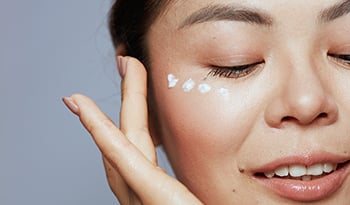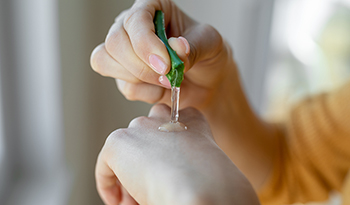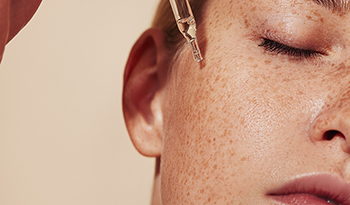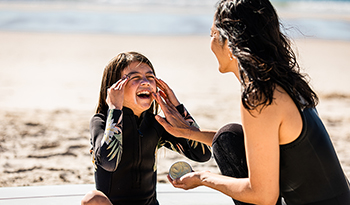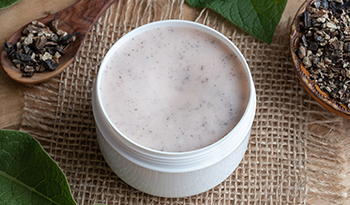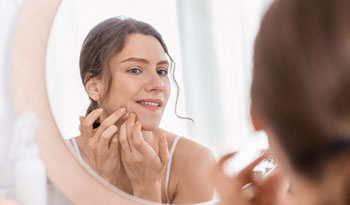Types Of Sunscreen: Which Is Best For You, According To A Dermatologist
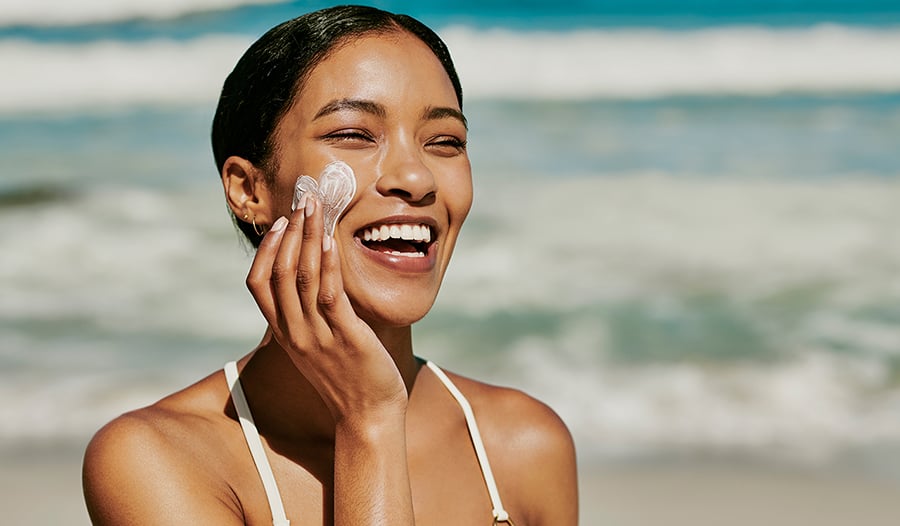
I love summertime.
I am also a dermatologist.
Though I love summer fashion, barbecues, and the sheer energy and vibrance that comes with this colorful season, nothing makes me cringe more than witnessing those first waves of sunburns as we transition from spring to summer. As the sun starts shining brighter and pool days call your name, don’t forget about one of the most important steps in your skincare routine — sunscreen.
Whether you’re a skincare junkie, have a history of skin cancer, or are just trying to avoid looking like a lobster this summer, understanding the basics of how sunscreen works, what SPF means, and the difference between various ingredients and formulations will go a long way to keeping your skin healthy all year round.
Sunscreen: The Basics
Sunscreen is a topical product meant to protect skin from the sun’s damaging ultraviolet (UV) rays. The two main types of UV radiation are UVA and UVB. UVA (“aging” rays) have longer wavelengths and penetrate deeper into the skin. They are responsible for premature skin aging. UVB (“burning” rays) have shorter wavelengths and are primarily responsible for causing sunburns.
Chronic and repeated exposure to both types of UV radiation causes DNA damage within cells, increasing the risk of skin cancer. In addition, excessive lifetime UV exposure causes telltale signs of aging (think sunspots and wrinkles on the face, hands, and neck) and can exacerbate disorders of hyperpigmentation, such as melasma.
What Is SPF?
Sunscreen is regulated by the FDA as an over-the-counter drug, making it subject to strict requirements and stringent testing before it is deemed safe to hit the shelves. Sun protection factor (SPF) is the global standard for measuring a sunscreen’s ability to protect against UVB rays — the ones that cause sunburns. The American Academy of Dermatology recommends “broad-spectrum” sunscreen (protecting against both UVA and UVB rays) with SPF 30 or higher.
But what does that SPF number actually mean? Here’s how it works:
- SPF 15: blocks approximately 93% of UVB rays
- SPF 30: blocks approximately 97% of UVB rays
- SPF 50: blocks approximately 98% of UVB rays
The takeaway? Higher SPF does offer more protection. However, that difference becomes smaller as the numbers go up. No sunscreen blocks 100% of UV rays.
What Are the Different Types of Sunscreens?
There are two broad categories of sunscreens: chemical and physical sunscreens. The differences come down to the active ingredients and how they work to protect against UV rays.
Chemical Sunscreen
A chemical sunscreen contains active ingredients like avobenzone, homosalate, and octisalate, to name just a few. These UV filters are organic compounds that absorb UV radiation and convert it to heat, which then dissipates from the skin’s surface.
Chemical sunscreens are lightweight, easy to rub in, and tend to blend elegantly with all skin tones, but may cause irritation in those with sensitive skin. They also require some time to work and must be applied about 20 minutes prior to sun exposure to ensure adequate protection.
Mineral Sunscreen
Mineral sunscreens (also called “physical” sunscreens) contain zinc oxide, titanium dioxide, or a blend of both. Mineral sunscreens both absorb and reflect UV radiation and are inherently broad-spectrum.
Historically, these are the sunscreens that left behind the dreaded “white cast” or ghostlike white-gray tinge to the skin. The emergence of tinted options and more advanced formulations has made mineral sunscreens an acceptable option for a wider audience in recent years, even in those with darker skin tones.
They are less likely to cause irritation and are the sunscreen of choice for babies and children ages 6 months and older (the American Academy of Pediatrics advises against sunscreen use in babies younger than 6 months, instead recommending shade, sun protective clothing, and sun avoidance in this age group).
Hybrid Sunscreens
If you come across a sunscreen containing both physical and chemical filters, this is called a hybrid sunscreen. The result is a combination of the best qualities of both mineral and chemical UV filters, as they offer broad-spectrum protection in a cosmetically elegant formulation with a low risk of irritation or allergic reactions.
Mineral vs. Chemical: How to Choose the Right Sunscreen
One type is not necessarily better than the other — both mineral and chemical sunscreens offer good protection, so choosing the right type largely boils down to personal preference. Your lifestyle and activities may influence which product will work best for you.
For prolonged outdoor activities when sweating and/or swimming is anticipated, choosing a water-resistant product is essential. Chemical sunscreens tend to be more inherently water-resistant than mineral sunscreens, washing off less easily (though either type should still be reapplied every 2 hours to give your skin peak protection!).
If you’re on the go and don’t have time to wait for your sunscreen to activate, a mineral sunscreen starts working faster. For those of us working from home indoors but near windows or with significant screen time, a tinted sunscreen with visible light protection may be beneficial.
Different Forms Of Sunscreen
There are also various forms of sunscreens to fit your different lifestyle needs. Toddler who won’t stand still? Hairy back or arms that make applying creams a nightmare? Reapplying sunscreen over makeup? Turns out, there is a sunscreen product out there for you:
- Lotions: Truly the traditional favorite among sunscreen types, you can never go wrong with lotions. SPF lotions are thought to provide the most even and reliable coverage, are easiest to spread over large areas of the body, and come in a variety of SPFs at affordable price points.
- Cream: If you want your sunscreen to double as a moisturizer, a cream-based product might be right for you. They offer excellent protection, as lotions do, but are thicker in consistency to hydrate dry skin.
- Stick: a favorite among parents of wiggly children, sunscreen sticks are an attractive option due to their compact, mess-free nature. While multiple passes are required to achieve the promised level of protection, and care must be taken not to miss a spot, these are a convenient option for reapplication of targeted locations (face, nose, ears), touch-ups, and travel.
- Spray: Sunscreen sprays and mists are fast, lightweight, and particularly useful for getting sunscreen onto hard-to-reach places. They’re also handy for individuals with body hair that might otherwise make sunscreen application a nuisance. Extra care must be taken to rub in the product to ensure adequate coverage. Additionally, inhaling aerosols should also be avoided.
- Gels: Those with oily skin may want to opt for a gel-based sunscreen, as these tend to be non-greasy, dry quickly, and have transparent application.
- Powders: Sunscreen powders are a great, fast way to reapply sunscreen over makeup on the go. They also tend to have a matte finish, which those with oily skin may appreciate.
Special Considerations
Finally, there may be some specific or unique concerns to take into consideration when choosing a sunscreen:
- Sensitive or reactive skin: Mineral or hybrid sunscreens are generally preferred for people whose skin is prone to irritation.
- Hyperpigmentation: Tinted mineral sunscreens that contain iron oxides offer added protection against visible light thought to contribute to dark spots and hyperpigmentation.
- Darker skin tones: Though mineral sunscreens have come a long way, many mineral products falsely claim to be “sheer” or “universal.” Chemical sunscreen is the safest bet for a lightweight option that doesn’t leave a white cast.
- For use with makeup: Chemical or hybrid sunscreens tend to be easier to blend and layer with other products.
How to Apply Sunscreen (The Right Way)
Ensure your sunscreen is broad-spectrum with a minimum SPF of 30. Apply sunscreen to all exposed skin any time you plan to spend time outdoors — even on overcast days or days with incidental sun exposure (driving in your car, sitting near a window, etc.)!
Sunscreen works best when applied approximately 15 to 20 minutes before going outside. And you probably need more than you think — the average adult needs about a shot glass worth (1 ounce) to cover the whole body.
With prolonged time outdoors, reapply sunscreen every two hours and after swimming or heavy sweating. Don’t forget to apply to the scalp, ears, lips, neck, backs of the hands, and tops of the feet — these areas are commonly missed and therefore prone to a surprise sunburn.
Final Thoughts
Personal preference, age, skin type, skin tone, lifestyle, and anticipated activities all come into play when choosing the right sunscreen. Everyone can benefit from consistent sunscreen use, whether you have a high risk of sunburns and skin cancer or cosmetic concerns. For maximal protection, incorporate other sun-safe practices, like sun-protective clothing, seeking shade when available, and avoiding sun during the peak hours of 10 a.m. to 2 p.m.
These are the many considerations I discuss with patients when it comes to selecting a sunscreen product. But at the end of the day, I prefer any sunscreen over none at all. Use what you love and enjoy your summer — safely!
References:
- American Academy of Dermatology (AAD). Sunscreen FAQs. Accessed June 1, 2025.
ODRICANJE OD ODGOVORNOSTI: Ovaj Wellness kutak nije namijenjen za pružanje dijagnoza...

















































































 Sadržaj
Sadržaj



